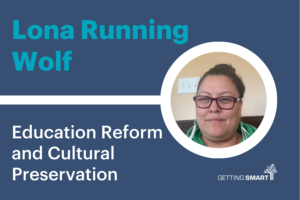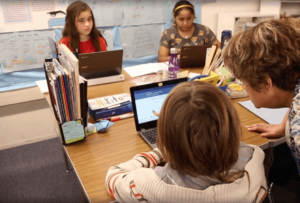How The EdTech Accelerator Model Needs To Change

By Katie Boody
At LEANLAB Education, we believe that true educational equity will only be achieved when we acknowledge two things:
1. The current American education system is insufficiently preparing all children for the future; it will require innovation to do so. We must conceive and build new systems, technologies, and tools that better equip and empower our schools to prepare all children for the future.
2. We have historically cut out “the end users” of education—our parents, students, teachers—in the process of building new education initiatives, to the detriment of our children. We believe that those closest to education itself are the true experts and have the experience, talent, and insights required to radically propel our industry forward.
Aligned with this belief, we spent the last five years incubating and launching 28 education ventures through our incubator/accelerator program. Urgent about how all children deserve access to imaginative and effective learning tools that prepare them for the future, we got to work in the fall of 2013, rapidly launching new innovations—pedagogies, services, tools, products, and technologies—with the potential to transform learning outcomes through our incubator program. It’s important to note that we have had success. Our ventures who have thrived the most—both commercially and with true student impact have demonstrated a resolute commitment to “end user” feedback that has been essential to propelling their ventures forward.
And yet, while we believed in the power of community, we were still guilty of keeping our community at arm’s length while incubating new education ventures. We hosted our education entrepreneur programming primarily within the protected siloes of conference rooms, not demanding their innovations or technologies be truly co-created in the authentic learning environments of schools and classrooms. And it was at our own peril. Our ventures, while novel, weren’t, at large, reaching the level of rapid growth and efficacy necessary to truly change outcomes for all children.
Meanwhile, we were not alone in misaligning our beliefs with our practices. Over the last few years, I’ve sat at more conferences and meetings than I can count where the rallying cry of “design with, not for communities” has been emphatically stated by other leaders of incubators, accelerators, and programs that promote innovation in education. But what does this adage really mean? What does “designing with” truly look like?
Like most entrepreneurs and innovators, we’ve done our fair share of iterating on our model and failing forward, and from what we’ve learned, I can tell you first what “designing with” does not look like in an incubator or accelerator setting:
- Over-relying on survey results and focus groups as a proxy for direct engagement with end-users
- Over-relying on the lived experience of the founder themselves (as a former educator or parent, for example)
- Over-relying on successful entrepreneurs or educational experts
- Over-relying on content and entrepreneur focused curriculum
- Over-relying on “sit and get” programming like classroom sessions, lectures and panel discussions
- Mistaking sales and revenue for evidence of impact and effectiveness
These practices in themselves are not bad, and elements of each of the above bullet points are, in fact, important in creating highly-effective and commercially-viable education innovations. What we’ve found, though, is that relying on only these methods alone is quite simply not enough.
So this is why we’ve shifted our approach to truly align to the belief that those most impacted by education—parents, students, and educators—are the true experts who deserve a seat at the table throughout the entire innovation process.
Our model has evolved, and our practices to “design with” communities have taken a turn to get hyper-close to communities we serve. We work to find the person most impacted by these innovations in each school site, and empower them with the tools and structures necessary to be co-creators. Today, our model looks like the following:
- Conducting a thorough, representative listening tour that gauges the needs of our school communities through rigorous, qualitative research practices, using one-on-one interviews, surveys and focus groups as a tool to surface “pain points” and ideas for innovations.
- Recruiting far and wide to find high potential entrepreneurs aligned with our communities needs, with a commitment to co-design in partnership with and in service to our school community
- Solidifying school partnerships that are representative of the greater communities needs, and who also have an interest in co-designing and implementing new innovations.
- Empowering these school partners to make the final decision in the companies we choose to incubate
- Embedding our entrepreneurs directly on our school sites, working in partnership with a designated “Lead End User”—or the most impacted user of the innovation—to actively co-design solutions
- Attaching a Ph.D. researcher to each co-design project, providing a structured method to ensure the end user’s agency in the process, and a way to collect meaningful data of learnings as innovations are iterated, improved and student gains are made.
We are still nascent in our learning, and this is admittedly a very new approach. What we do know is that by embracing this extreme proximity—by launching our entrepreneurs into direct relationships with the schools they seek to serve—honest conversations, unexpected relationships and accelerated learning are already taking place. We are embracing the journey, and thinking about what it means to grow these school partnership communities into connected networks that only further enhance the power of community voice.
For more, see:
- What Do Broad EdTech Trends Mean for Your School District?
- Making “It’s All About the Data” a Reality in Education
- Three Ongoing Trends in Education Data
Katie Boody is Founder and CEO of LEANLAB Education, an education innovation community and incubator based in Kansas City. Katie identifies as a former teacher, teacher leader and community organizer seeking to elevate parent, teacher and student voice while reimagining K-12 public education. Follow Katie on Twitter at @katieboody.
Stay in-the-know with all things edtech and innovations in learning by signing up to receive our weekly newsletter, Smart Update.




0 Comments
Leave a Comment
Your email address will not be published. All fields are required.